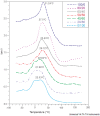Hydrophilic Films Based on Carboxymethylated Derivatives of Starch and Cellulose
- PMID: 33105874
- PMCID: PMC7690641
- DOI: 10.3390/polym12112447
Hydrophilic Films Based on Carboxymethylated Derivatives of Starch and Cellulose
Abstract
The carboxymethylated derivatives of starch (CMS) and cellulose (CMC) were used for film preparation. The infrared spectroscopy revealed that crosslinking via ester bridges with citric acid occurred between the two polysaccharide derivatives. The effect of polysaccharide derivatives ratio on physicochemical properties of prepared films was evaluated. Generally, the values of tested parameters (moisture absorption, surface roughness, and mechanical and thermal properties) were between the values noted for neat CMS or CMC-based films. However, the physicochemical properties of the system with equal CMS/CMC weight ratio diverged from this trend, i.e., the highest tensile strength, the highest Young's modulus (ca. 3.4 MPa and ca. 4.9 MPa, respectively), with simultaneously the lowest moisture absorption (18.5% after 72 h) have been noted. Such systems could potentially find application in agriculture or pharmacy.
Keywords: carboxymethyl cellulose; carboxymethyl starch; hydrophilic films; polysaccharide films.
Conflict of interest statement
The authors declare no conflict of interest.
Figures












References
-
- Spychaj T., Wilpiszewska K., Zdanowicz M. Medium and high substituted carboxymethyl starch: Synthesis, characterization and application. Starch. 2013;65:22–33. doi: 10.1002/star.201200159. - DOI
-
- Ghanbarzadeh B., Almasi H., Entezami A.A. Improving the barrier and mechanical properties of corn starch-based edible films: Effect of citric acid and carboxymethyl cellulose. Ind. Crops Prod. 2011;33:229–235. doi: 10.1016/j.indcrop.2010.10.016. - DOI
-
- Kittipongpatana O.S., Chaitep W., Charumanee S., Kittipongpatana N. Effects of amylose content on the physicochemical properties of sodium carboxymethyl rice starches. CMU J. Nat. Sci. 2006;5:199–207.
-
- Kim K.W., Ko C.J., Park H.J. Mechanical properties, water vapor permeabilities and solubilities of highly carboxymethylated starch-based edible films. J. Food Sci. 2002;67:218–222. doi: 10.1111/j.1365-2621.2002.tb11387.x. - DOI
-
- Kittipongpatana O.S., Chaichanasak N., Kanchongkittipoan S., Panturat A., Taekanmark T., Kittipongpatana N. An aqueous film-coating formulation based on sodium carboxymethyl mungbean starch. Starch. 2006;58:587–589. doi: 10.1002/star.200600528. - DOI
LinkOut - more resources
Full Text Sources

